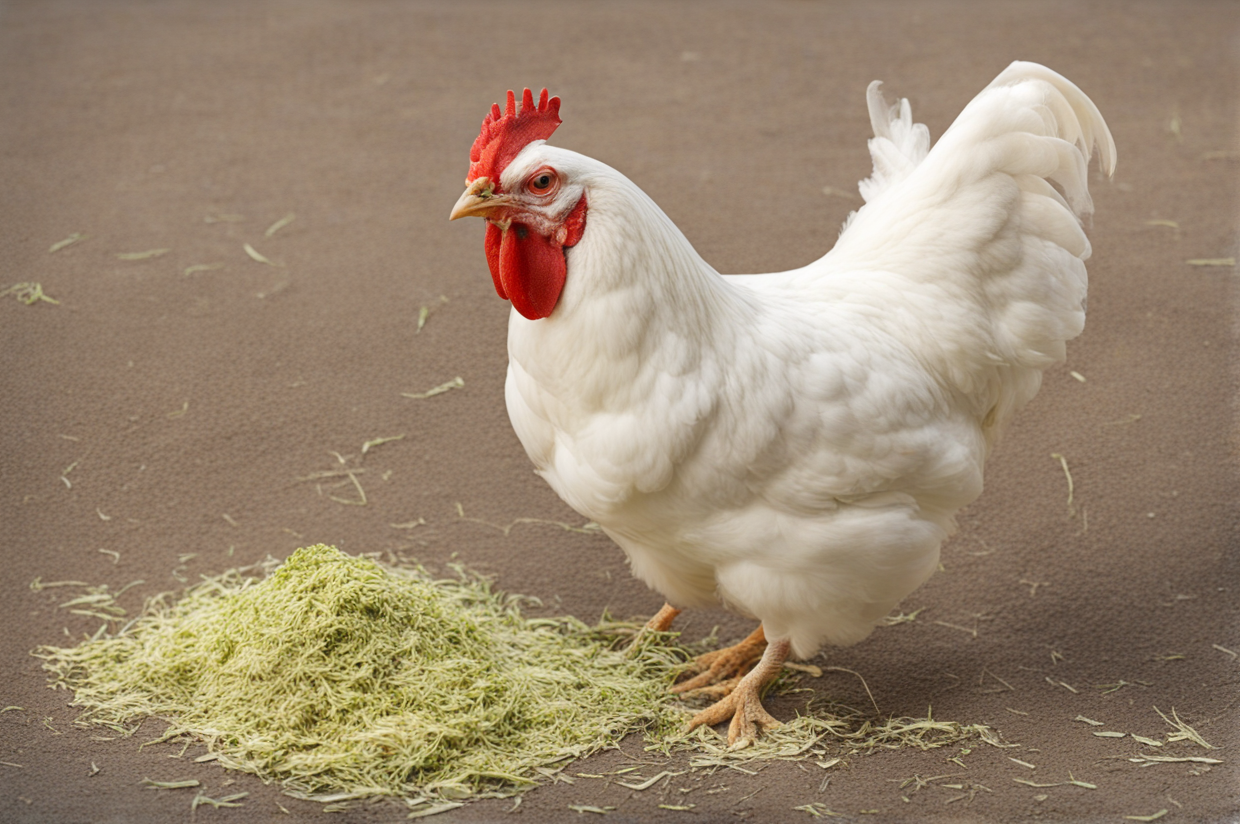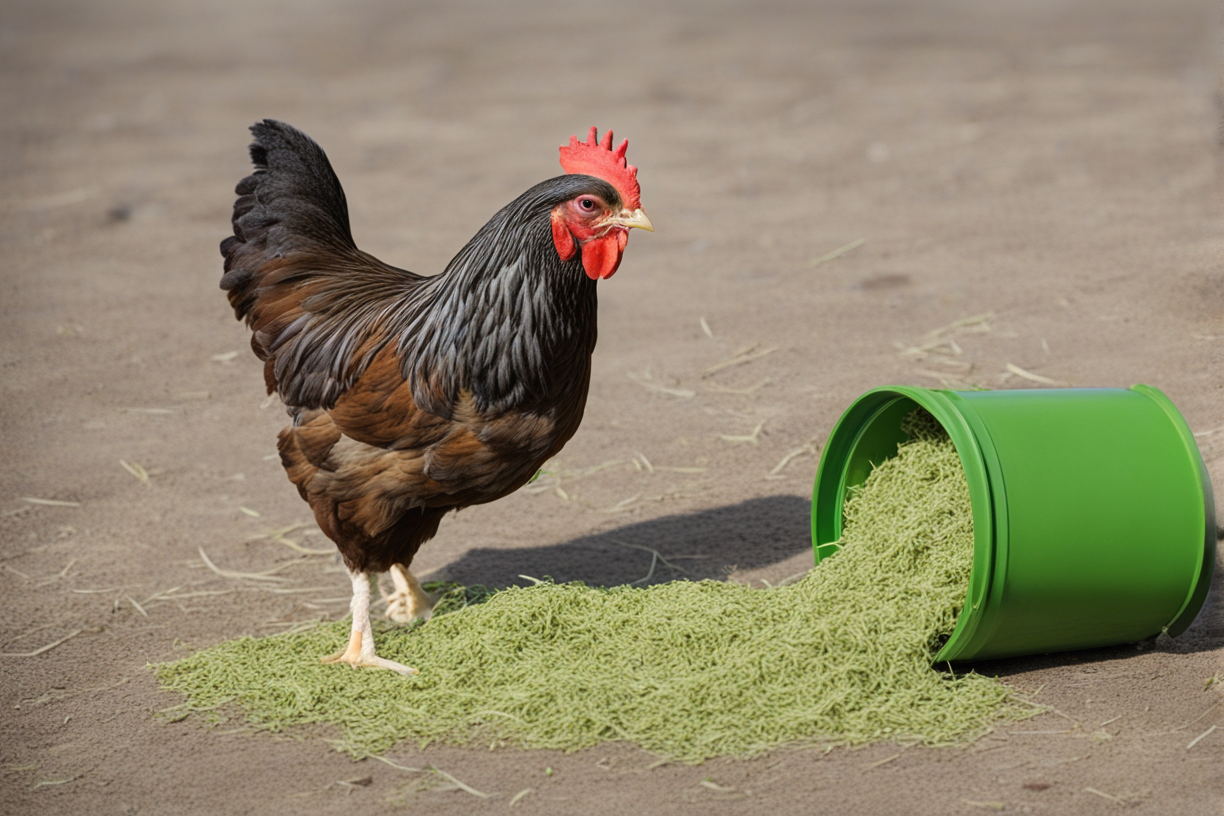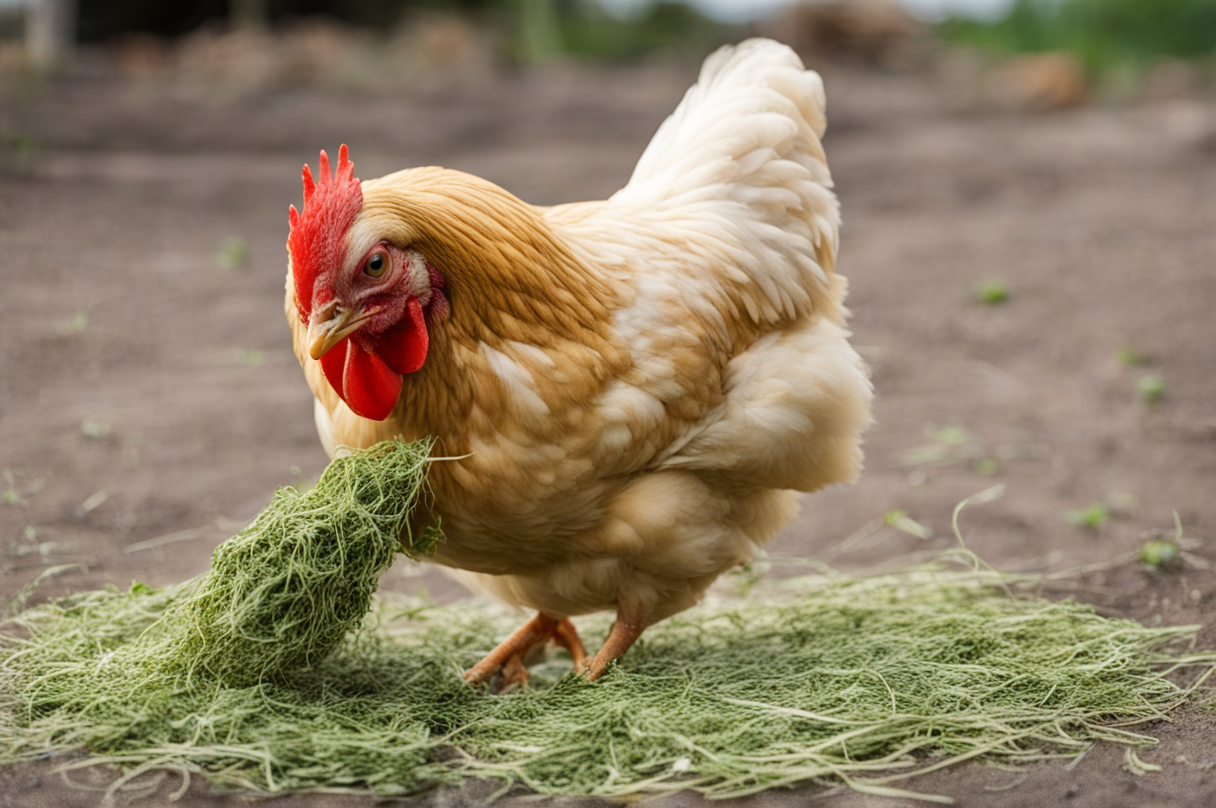I’ll never forget the time my pet chicken Pecker gobbled up a huge pile of dried alfalfa thinking it was her regular chicken feed.
That silly bird ate so much her crop was about to burst!
But after researching a bit more, I realized alfalfa isn’t so bad for chickens in moderation.
So let’s dig into the details:
Yes, chickens can eat dried alfalfa, but it should only make up a small part of their overall diet.
Alfalfa is high in protein, which chickens need, but too much can cause digestive issues.
Table of Contents
The Benefits of Alfalfa for Chickens

Alfalfa, also called lucerne, contains lots of good stuff like protein, vitamins, minerals, and antioxidants.
Here are some of the key nutrients chickens get from alfalfa:
Protein – Alfalfa contains 15-25% protein, which is essential for egg production.
The amino acids in alfalfa protein help chickens build muscle and produce eggs.
Just a handful of alfalfa a day can help boost protein levels for better egg laying.
Vitamins A, E, and K – Alfalfa has high levels of these key vitamins chickens need.
Vitamin A supports immunity and reproductive health.
Vitamin E is an antioxidant that fights disease and boosts egg fertility.
Vitamin K is needed for blood clotting and bone health.
Calcium – Alfalfa contains about 1.5% calcium, which is used to form strong eggshells.
The calcium in alfalfa also supports bone strength and growth.
Just a bit each day can help chickens get enough calcium for egg production.
Antioxidants – Alfalfa contains lots of antioxidants like vitamin E and vitamin C.
These antioxidants remove free radicals and lower inflammation.
This helps keep chickens healthy and enhances immune function.
So giving your flock a little alfalfa can provide some nice nutritional benefits.
The protein in particular is great for laying hens.
Risks of Too Much Alfalfa

Moderation is key though, because alfalfa is very high in protein.
Feeding chickens too much can cause issues like:
Kidney damage – Excess protein puts strain on chickens’ kidneys.
This can lead to kidney stones, infection, and even kidney failure over time.
Limit alfalfa to under 10% of the diet to avoid kidney trouble.
Egg binding – The high protein and calcium in alfalfa can cause eggs to get over-calcified and stuck.
Egg binding is extremely dangerous and can be fatal if the egg doesn’t pass.
Nutritional deficiencies – Too much alfalfa prevents chickens from eating a balanced diet.
They’ll miss out on other nutrients like vitamin B, phosphorus, etc.
This can cause all kinds of health problems down the road.
Loose droppings – The saponins in alfalfa irritate chickens’ digestive tracts.
Excess alfalfa causes runny, smelly poop which risks attracting predators.
Diarrhea also leads to dehydration and mineral depletion.
See, alfalfa contains something called saponins that can irritate a chicken’s digestive tract.
So they end up not absorbing nutrients properly.
Not good!
How Much Alfalfa to Feed Chickens

Here’s my recommendation on how much dried alfalfa to feed:
Adult chickens: No more than 10% of daily diet
For a typical flock, that’s:
1-2 ounces of alfalfa per chicken daily
About 1/4 cup of alfalfa for 3-5 hens
Too much more can cause health issues
Mix it into a balanced feed ration or offer free choice
Weigh out servings carefully to ensure proper amounts
Chicks: No more than 2% of daily diet
For chicks under 4 weeks old, feed:
1 teaspoon of alfalfa per chick daily
Sprinkle over crumbled starter feed
Reduce amount if loose droppings occur
Alfalfa is very rich for delicate chick digestive systems
They need even less than adult chickens
It’s easy to sprinkle some alfalfa into their feed ration or offer it free choice in a separate container.
But don’t go overboard!
The Best Way to Feed Alfalfa
If you want to share some alfalfa with your flock, here are a few tips:
Always pair it with their regular feed
Never replace their full ration with straight alfalfa
It does not contain all necessary nutrients
Chop or grind it into smaller pieces first
Whole leaves are hard for chickens to digest
Smaller bits are easier to eat
Use a coffee grinder, food processor, or scissors
Offer it dry, not soaked or sprouted
Wet alfalfa can spoil quickly
Dry alfalfa stores better
Introduce it slowly to avoid tummy troubles
Start with just a pinch
Gradually increase over 2-3 weeks
This allows their guts to adjust
Watch for loose droppings
And be sure they always have access to fresh water too.
The extra protein in alfalfa makes chickens thirsty!
So in closing, dried alfalfa can be a healthy treat for chickens in moderation.
Just don’t overdo it!
Pecker learned that lesson the hard way.
That silly bird is now limited to a handful per day, otherwise she’ll eat herself sick.
Chickens! Am I right?
Dried Alfalfa Hay vs. Pellets for Chickens
Alfalfa can be fed to chickens in two forms – as dried hay or as concentrated pellets.
Dried alfalfa hay is the leaves and stems of the alfalfa plant cut, dried, and baled.
It retains more of the original plant structure and requires chopping before feeding.
Alfalfa pellets are made by grinding up dried alfalfa into a compacted pellet form.
Pellets allow for more precise feeding and less waste compared to loose hay.
Hay provides chewing exercise and gut fill which can aid digestion.
But pellets are easier for chickens to consume and don’t need pre-chopping.
Both forms provide the same nutritional value.
I recommend offering chickens a mix of chopped hay and pellets for variety.
Try scattering pellets in feeders and stuffing hay in treat balls or forage trays.
This allows free choice feeding and provides activity.
Store alfalfa hay properly to prevent spoilage and waste.
Keep it in a dry area out of direct sun and moisture.
Situate hay racks under cover to keep it dry.
Discard moldy or rotting portions which can make chickens sick.
Alfalfa pellets last longer when stored in rodent-proof bins.
Calculate amounts fed carefully based on flock size and intake.
Weigh out portions rather than feeding free choice.
This prevents chickens gorging themselves on unlimited pellets.
Both hay and pellets are great options for feeding chickens alfalfa safely.
I recommend a balanced blend along with their complete feed.
Growing Alfalfa for Chickens in the Garden
Can’t find good quality alfalfa hay or it’s too expensive?
Consider planting and growing your own alfalfa patch just for your chickens!
Alfalfa is easy to grow in a garden bed or corner of the yard.
It prefers full sun and well drained soil with a neutral pH.
Work compost and fertilizer into soil before planting.
Sow seeds directly in the ground 1/4-1/2″ deep in early spring after the last frost.
Or start seeds indoors and transplant seedlings when soil reaches 60°F.
Space plants 6-12″ apart in rows 12-18″ apart.
Water thoroughly and keep soil moist but not soggy.
Clip off flowers in the first year to encourage leafy growth.
Alfalfa will regrow after cutting all summer long.
Harvest by cutting stems 2-3″ above the soil when plants reach 1′ high.
Let plants dry out for a few days then gather stems into bunches.
Hang bundles upside down to finish drying for 1-2 weeks.
To feed chickens, chop dried leaves and stems into smaller pieces.
Or put through a wood chipper to break them down.
Store Homegrown alfalfa in a dry spot until ready to use.
Alfalfa will come back each year without re-planting.
Cut frequently to encourage regrowth for continual harvests.
Add fresh cuttings right to chicken coops or runs for foraging.
Growing your own alfalfa ensures a quality, fresh supply all season.
Using Alfalfa Meal for Chickens
Another option is feeding your flock alfalfa meal or alfalfa leaf meal.
This is made by finely grinding dried alfalfa into powder form.
Alfalfa meal contains highly concentrated nutrition in a digestible form.
It is over 30% protein and rich in vitamins and minerals.
The powdery texture sprinkles nicely over feed or mashes.
Alfalfa meal has more protein than pellets but less fiber.
Use sparingly as it is very rich and high in minerals.
Mix just a pinch into feed at first to avoid diarrhea.
Slowly increase amount as chickens adjust.
Limit alfalfa meal to 1-2 tablespoons per chicken weekly.
Do not exceed 5% of the total diet.
To serve, sprinkle over crushed pellets, mash, or grains.
Stir well to distribute evenly and prevent selective eating.
Leftovers will quickly go stale so only mix up what will be eaten in one meal.
Store in an airtight container away from moisture.
Alfalfa meal packs a nutritional punch but dosing must be controlled.
Use a kitchen scale to weigh out precise amounts based on flock size.
Free choice feeding risks health issues.
Sprouting Alfalfa for Chickens
Sprouting alfalfa unlocks even more nutritional benefits for chickens.
Sprouting triggers the release of enzymes and converts nutrients into a more bioavailable form.
This boosts the overall protein, vitamin, and mineral content.
Chickens readily eat sprouted seeds and it improves digestion.
The sprouting process is simple:
Soak seeds 8-12 hours then drain well.
Transfer to a sprouting tray or jar, rinse twice daily.
Seeds sprout in 5-7 days.
When sprouts are 1-2 inches, put trays in a sunny spot for 12 hours.
This turns sprouts green and boosts vitamin levels.
Finally, allow them to dry out a bit before feeding.
Chickens will eagerly devour the tender green sprouts.
Start with just a handful per chicken and increase over time.
Too much too fast can upset sensitive digestion.
Try different sprouts like clover, radish, mung beans.
Mixes provide variety and a range of nutrients.
Rotate in new batches while another round sprouts.
Having a continual supply makes it easy to offer fresh sprouts daily.
Sprouting takes time but provides great nutritional and gut health benefits.
Feeding Chickens Alfalfa Scraps from Rabbits/Horses
If you have rabbits, horses, or other animals eating alfalfa, don’t let the leftovers go to waste.
Chickens will happily gobble up alfalfa scraps after other animals have nibbled on it.
These leftovers still provide useful nutrition for chickens.
The animals remove the tastiest, most palatable bits first.
But plenty of protein and nutrients remain in the stems and fragments.
Chickens are not picky and will clean it all up.
Scraps may be more stemmy or woody but chickens can break them down.
Their gizzards effectively grind and digest fibrous material.
Before feeding scraps, inspect carefully and discard any soiled or molded portions.
Chop or break it down into smaller pieces for easier eating.
Try stuffing bits into a suet feeder or packed into an old plastic bottle.
This forces chickens to
This forces chickens to work and nibble away at the alfalfa scraps.
Spreading them out over the ground or lawn also promotes foraging activity.
Just be sure scraps make up a small portion of the overall diet.
They lack the completeness of pure dried alfalfa products.
Always provide a quality complete feed in addition to any foraged scrap treats.
Monitor to ensure chickens are actually eating the scraps.
Some may reject woody, stemmy bits if given other choices.
But letting chickens clean up alfalfa scraps is a great way to reduce waste.
It provides entertainment, activity, and bonus nutrition.
Just be selective about quality and watch feeding amounts.
With a few precautions, alfalfa scraps make an eco-friendly chicken snack!
